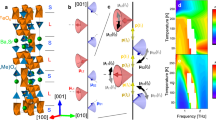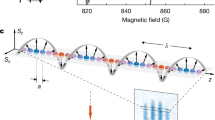Abstract
Quantum statistics and symmetrization dictate that identical fermions do not interact via s-wave collisions. However, in the presence of spin–orbit coupling (SOC), fermions prepared in identical internal states with distinct momenta become distinguishable. The resulting strongly interacting system can exhibit exotic topological and pairing behaviours, many of which are yet to be observed in condensed matter systems. Ultracold atomic gases offer a promising pathway for simulating these rich phenomena, but until recently have been hindered by heating and losses. Here we enter a new regime of many-body interacting SOC in a fermionic optical lattice clock (OLC), where the long-lived electronic clock states mitigate unwanted dissipation. Using clock spectroscopy, we observe the precession of the collective magnetization and the emergence of spin-locking effects arising from an interplay between p-wave and SOC-induced exchange interactions. The many-body dynamics are well captured by a collective XXZ spin model, which describes a broad class of condensed matter systems ranging from superconductors to quantum magnets. Furthermore, our work will aid in the design of next-generation OLCs by offering a route for avoiding the observed large density shifts caused by SOC-induced exchange interactions.
This is a preview of subscription content, access via your institution
Access options
Access Nature and 54 other Nature Portfolio journals
Get Nature+, our best-value online-access subscription
$29.99 / 30 days
cancel any time
Subscribe to this journal
Receive 12 print issues and online access
$209.00 per year
only $17.42 per issue
Buy this article
- Purchase on Springer Link
- Instant access to full article PDF
Prices may be subject to local taxes which are calculated during checkout




Similar content being viewed by others
References
Qi, X.-L. & Zhang, S.-C. Topological insulators and superconductors. Rev. Mod. Phys. 83, 1057–1110 (2011).
Barbarino, S., Taddia, L., Rossini, D., Mazza, L. & Fazio, R. Synthetic gauge fields in synthetic dimensions: interactions and chiral edge modes. New. J. Phys. 18, 035010 (2016).
Strinati, M. C. et al. Laughlin-like states in bosonic and fermionic atomic synthetic ladders. Phys. Rev. X 7, 021033 (2017).
Zeng, T.-S., Wang, C. & Zhai, H. Charge pumping of interacting fermion atoms in the synthetic dimension. Phys. Rev. Lett. 115, 095302 (2015).
Zhai, H. Degenerate quantum gases with spin–orbit coupling: a review. Rep. Prog. Phys. 78, 026001 (2015).
Goldman, N., Juzeliūnas, G., Öhberg, P. & Spielman, I. B. Light-induced gauge fields for ultracold atoms. Rep. Prog. Phys. 77, 126401 (2014).
Celi, A. et al. Synthetic gauge fields in synthetic dimensions. Phys. Rev. Lett. 112, 043001 (2014).
Galitski, V. & Spielman, I. B. Spin-orbit coupling in quantum gases. Nature 494, 49–54 (2013).
Goldman, N., Dalibard, J., Aidelsburger, M. & Cooper, N. R. Periodically driven quantum matter:the case of resonant modulations. Phys. Rev. A 91, 033632 (2015).
Dalibard, J., Gerbier, F., Juzeliūnas, G. & Öhberg, P. Colloquium: artificial gauge potentials for neutral atoms. Rev. Mod. Phys. 83, 1523–1543 (2011).
Wall, M. L. et al. Synthetic spin-orbit coupling in an optical lattice clock. Phys. Rev. Lett. 116, 035301 (2016).
Lin, Y.-J., Jiménez-García, K. & Spielman, I. B. A spin-orbit coupled Bose–Einstein condensate. Nature 471, 83–86 (2011).
Fu, Z. et al. Radio-frequency spectroscopy of a strongly interacting spin–orbit-coupled Fermi gas. Phys. Rev. A 87, 053619 (2013).
Ha, L.-C., Clark, L. W., Parker, C. V., Anderson, B. M. & Chin, C. Roton-Maxon excitation spectrum of Bose condensates in a shaken lattice. Phys. Rev. Lett. 114, 055301 (2015).
Li, J. R. et al. A stripe phase with supersolid properties in spin-orbit-coupled Bose–Einstein condensates. Nature 543, 91–94 (2017).
Tai, M. E. et al. Microscopy of the interacting Harper–Hofstadter model in the few-body limit. Nature 546, 519–523 (2017).
Kolkowitz, S. et al. Spin-orbit-coupled fermions in an optical lattice clock. Nature 542, 66–70 (2017).
Livi, L. F. et al. Synthetic dimensions and spin-orbit coupling with an optical clock transition. Phys. Rev. Lett. 117, 220401 (2016).
Martin, M. J. et al. A quantum many-body spin system in an optical lattice clock. Science 341, 632–636 (2013).
Zhang, X. et al. Spectroscopic observation of SU(N)-symmetric interactions in Sr orbital magnetism. Science 345, 1467–1473 (2014).
Anderson, P. W. Random-phase approximation in the theory of superconductivity. Phys. Rev. 112, 1900–1916 (1958).
Matsunaga, R. et al. Light-induced collective pseudospin precession resonating with Higgs mode in a superconductor. Science 345, 1145–1149 (2014).
Deutsch, C. et al. Spin self-rephasing and very long coherence times in a trapped atomic ensemble. Phys. Rev. Lett. 105, 020401 (2010).
Du, X., Luo, L., Clancy, B. & Thomas, J. E. Observation of anomalous spin segregation in a trapped Fermi gas. Phys. Rev. Lett. 101, 150401 (2008).
Zhang, J. et al. Observation of a discrete time crystal. Nature 543, 217–220 (2017).
Choi, S. et al. Observation of discrete time-crystalline order in a disordered dipolar many-body system. Nature 543, 221–225 (2017).
Rey, A. M. et al. Probing many-body interactions in an optical lattice clock. Ann. Phys. 340, 311–351 (2014).
Bishof, M. et al. Inelastic collisions and density-dependent excitation suppression in a 87Sr optical lattice clock. Phys. Rev. A 84, 052716 (2011).
Lemke, N. D. et al. p-wave cold collisions in an optical lattice clock. Phys. Rev. Lett. 107, 103902 (2011).
Viola, L. & Lloyd, S. Dynamical suppression of decoherence in two-state quantum systems. Phys. Rev. A 58, 2733–2744 (1998).
Campbell, S. L. et al. A Fermi-degenerate three-dimensional optical lattice clock. Science 358, 90–94 (2017).
Isaev, L., Schachenmayer, J. & Rey, A. M. Spin-orbit-coupled correlated metal phase in Kondo lattices: An implementation with alkaline-earth atoms. Phys. Rev. Lett. 117, 135302 (2016).
de Lange, G., Wang, Z. H., Ristè, D., Dobrovitski, V. V. & Hanson, R. Universal dynamical decoupling of a single solid-state spin from a spin bath. Science 330, 60–63 (2010).
Slichter, C. P. Principles of Magnetic Resonance (Springer-Verlag, Berlin, 1996).
Schachenmayer, J., Pikovski, A. & Rey, A. M. Dynamics of correlations in two-dimensional quantum spin models with long-range interactions: a phase-space Monte-Carlo study. New. J. Phys. 17, 065009 (2015).
Acknowledgements
We are grateful to M. Lukin, S. Yelin, V. Gurarie, M. Foster, S. L. Campbell, A. Goban, R. B. Hutson, G.E. Marti, E. Oelker, J. Robinson, L. Sonderhouse and D. G. Reed for stimulating discussions and technical contributions. We thank M. Norcia and A. Kaufman for their careful reading of the manuscript. This research is supported by NIST, DARPA, JILA Physics Frontier Center (NSF-PFC-1125844), AFOSR-MURI, and AFOSR. C.S. is partially supported by the JILA Visiting Fellow Program.
Author information
Authors and Affiliations
Contributions
S.L.B., S.K., T.B., D.K. and J.Y. contributed to the executions of the experiments. A.S.-N., M.L.W. and A.M.R. developed the theory model. All authors discussed the results, contributed to the data analysis and worked together on the manuscript.
Corresponding author
Ethics declarations
Competing interests
The authors have no competing financial interests.
Additional information
Publisher’s note: Springer Nature remains neutral with regard to jurisdictional claims in published maps and institutional affiliations.
Supplementary information
Supplementary Information
Supplementary Figure 1–3
Rights and permissions
About this article
Cite this article
Bromley, S.L., Kolkowitz, S., Bothwell, T. et al. Dynamics of interacting fermions under spin–orbit coupling in an optical lattice clock. Nature Phys 14, 399–404 (2018). https://doi.org/10.1038/s41567-017-0029-0
Received:
Accepted:
Published:
Issue Date:
DOI: https://doi.org/10.1038/s41567-017-0029-0
This article is cited by
-
Direct comparison of two spin-squeezed optical clock ensembles at the 10−17 level
Nature Physics (2024)
-
Strongly interacting Rydberg atoms in synthetic dimensions with a magnetic flux
Nature Communications (2024)
-
Interaction-induced topological transition in spin-orbit coupled ultracold bosons
Science China Physics, Mechanics & Astronomy (2023)
-
Resolving the gravitational redshift across a millimetre-scale atomic sample
Nature (2022)
-
Controlling the interaction of ultracold alkaline-earth atoms
Nature Reviews Physics (2020)



